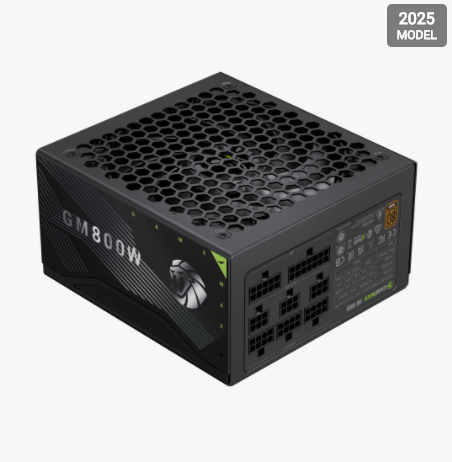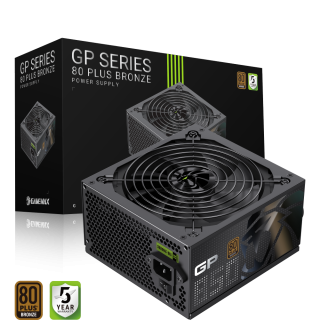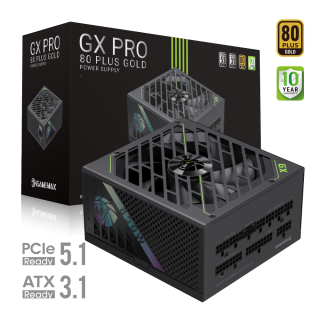When building or upgrading a computer, selecting the right power supply unit (PSU) is crucial. Beyond power capacity, the 80 PLUS certification levels (such as Bronze and Gold) are core indicators of a PSU’s energy efficiency. This article delves into the differences between Bronze and Gold PSUs to help you make an informed choice based on your needs.
80 PLUS certification evaluates conversion efficiency across three load scenarios: 20% light load, 50% typical load, and 100% full load. The specific requirements for Bronze and Gold are:

Bronze: ≥82% efficiency at 20% load, ≥85% at 50% load, ≥82% at 100% load.
Gold: ≥87% efficiency at 20% load, ≥90% at 50% load, ≥87% at 100% load.
This means Gold PSUs offer significantly higher efficiency across all load ranges. For example, at 50% load (e.g., gaming or rendering), a Gold PSU consumes about 111W input power to deliver 100W output, while a Bronze PSU requires ~117W—an obvious gap.
Electricity Cost Savings
At 50% load and 8 hours of daily use, a Gold PSU can save approximately $4.8 (assuming $0.11/kWh) annually compared to a Bronze unit. For systems under constant high load (e.g., servers), the savings are more substantial. An 800W Platinum PSU, for instance, could save 331 kWh annually over a Gold unit, making it ideal for enterprise applications.
Heat Dissipation and Noise
Gold PSUs generate less heat due to higher efficiency, often requiring lower fan speeds. For example, a Bronze PSU might run at 1600rpm under full load, while a Gold unit can stay below 1200rpm, reducing noise significantly. Lower heat output also slows capacitor aging, extending the PSU’s lifespan.
Ripple and Stability
Ripple refers to voltage fluctuations in the output, which can affect hardware stability. While Gold PSUs excel in efficiency, ripple control isn’t absolute. For instance, a Bronze PSU might have +12V ripple of 38mV, outperforming some Gold units at 53mV—highlighting that real-world performance depends on design, not just certification.

Gold PSUs typically cost 20–40% more than Bronze units of the same power. For example, a 500W Bronze PSU might cost $28, while a Gold unit ranges from $35–$42. For average users, calculate the payback period: if the price difference is $7, and annual savings are $4.8, it takes ~1.5 years to recoup the cost. Bronze offers better cost-effectiveness for low-usage scenarios (e.g., office work), while Gold shines in long-term, high-load use (e.g., gaming or rendering).
Bronze PSUs:
Suited for budget-conscious users, office setups, or light entertainment. For a 200W office PC, a Bronze PSU at 50% load (85% efficiency) suffices, with a clear price advantage.
Gold PSUs:
Recommended for gamers, content creators, and users requiring long-term stability. High-power systems with top-tier GPUs (e.g., RTX 4090) or overclocked CPUs benefit from Gold PSUs, which reduce heat and enhance stability—especially during extended rendering or gaming sessions.
Certification ≠ Quality
80 PLUS measures efficiency, not stability. PSU reliability depends on capacitor quality, protection mechanisms (e.g., OVP/UVP), and cooling design. Some Bronze PSUs with Japanese capacitors may outperform subpar Gold units in ripple control.
Narrower Efficiency Gap at Low Loads
At 20% load (e.g., standby), Bronze (82%) and Gold (87%) efficiency differences are minimal. If your PC runs at low loads most of the time, Bronze is more cost-effective.
Future Compatibility
Gold PSUs often use advanced circuit designs (e.g., LLC resonant topology) for better support of future hardware. For example, the ATX 3.0 standard’s stricter transient power requirements are better met by Gold PSUs with redundant designs.
Opt for Gold: High-power systems, long-term use, or prioritizing silence and stability.
Choose Bronze: Tight budgets or low-load daily applications.
Key Metrics: Beyond certification, consider power matching (leave 20% headroom), modular design (for cable management), and brand reputation.
Ultimately, PSU selection should align with practical needs rather than chasing high certifications blindly. Whether Bronze or Gold, ensuring stable power supply and long-term reliability remains the core goal.

GAMEMAX GP 850B 80+ Bronze Ultra-Stable Power Supply with Dual DC-DC Control, Smart Fan, and Premium Heat Dissipation.
• Dual Control DC-DC Circuit: Features 180-degree phase-shifted 3.3V/5V outputs, minimizing impact on +12V input and reducing ripple noise for enhanced stability and ±2% voltage accuracy.
• Premium Taiwanese Capacitors: Utilizes high-quality TEAPO capacitors for reliable full-load performance and stable power delivery.
• Smart Temperature Control Fan 14CM: Automatically adjusts fan speed based on load, balancing energy efficiency and low-noise operation.
• Double-Sided PCB with Top-Side SMD Layout: Single-sided component design (no bottom components) improves stability and manufacturing precision.
• Enhanced Heat Dissipation: Aluminum extrusion and optimized crystal heat dissipation architecture ensure efficient cooling for sustained performance.

GX PRO 850G 80 Plus Gold Modular Power Supply: ATX3.1 Ready, Silent Cooling, & Premium Durability
• 80 Plus Gold Efficiency & Quiet Operation: Achieves 90% efficiency under typical loads with APFC+LLC+DC-DC design, minimizing power waste and noise.
• Premium Durability & Reliability: Built with Japanese 105°C capacitors and solid capacitors for long-term stability and performance.
• ATX3.1 & PCIe5.1 Ready: Features a native 12V-2x6 connector for seamless RTX 40/50 GPU compatibility and efficient power delivery.
• Advanced Thermal Management: 13.5cm FDB fan with intelligent temperature control ensures quiet cooling and optimal heat dissipation.
• Modular Design & Robust Protection: Fully modular layout with dual-stage EMI filtering and NTC thermistor safeguards against surges, while gold-plated cables ensure durable, high-conductivity connections.